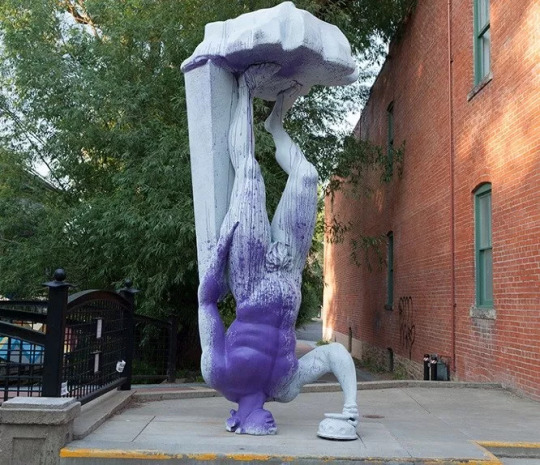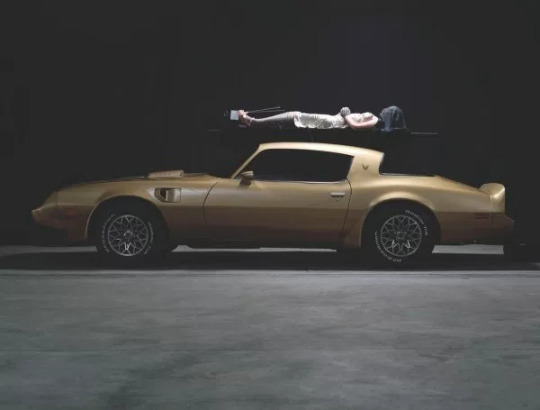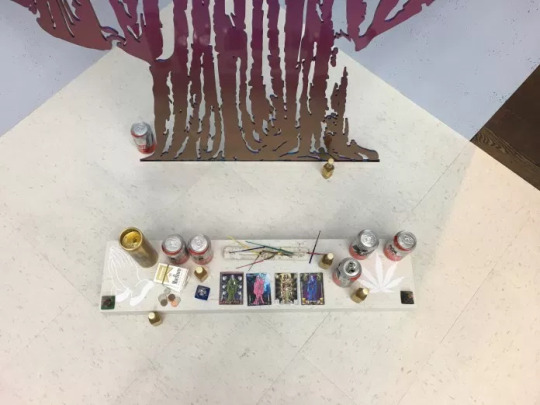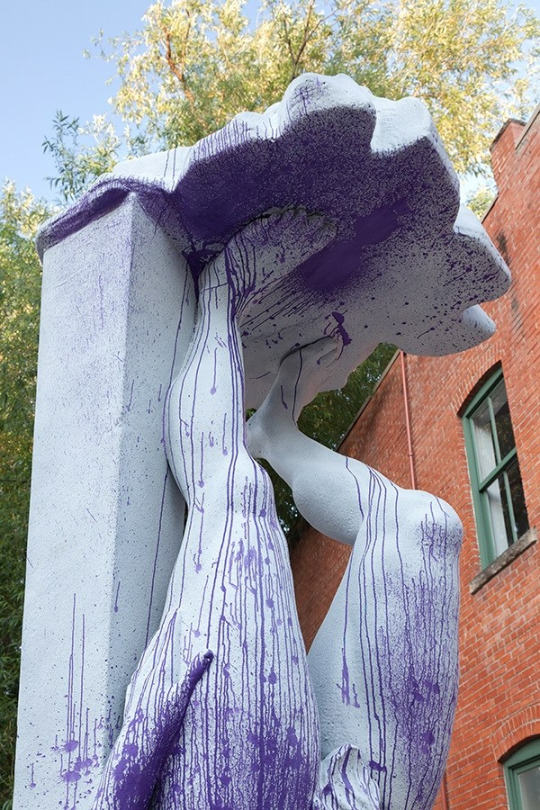#and North Korea might be too if they’re petty enough
Text
Dmitri Obergfell: Death of the Cool
via One Good Eye (Denver)

INTRO:
This is the first of a series of experimental writings about, and in collaboration with, select Denver artists. Having no specific agenda other than an interest in these artists’ work, the plan is to have a conversation with them in their studio about whatever happens to come up. There’s no Q&A, no topics to necessarily cover, and honestly, if there’s one thing I want from these experiments, it’s for them to feel different than your typical artist interview. A conversation that is true to the work and the personalities of the artists and myself.
I hope to document the personality of the conversation itself. So keeping the process organic beyond their studio and back into my own, the writing produced will inherit the thematic trajectory of the dialogue directly, with my role as writer being to subsume both peoples’ viewpoints, conclusions, questions, answers, misdirections, etc., into a single, weirdly tangential perspective.
DMITRI OBERGFELL: THE DEATH OF THE COOL

Dmitri Obergfell’s process fills the entire main space of Leisure Gallery, his current studio, in preparation for his show, Man is a Bubble and Time Is a Place, opening at Gildar Gallery March 23. Rap music from Macbook speakers echoes around our conversation. The entire time I was in there, he never paused from making molds. I started in at the natural place: What’s this show about?
Basically, it’s a meditation on “Deep Time” — an idea sampled from 2001: A Space Odyssey (the book), in which one of the most defining moments was the first time a proto-human got bored. Thus began the search for meaning, leading to the creation of symbols, the original “victory over time” that allowed information to be passed to future generations. But this sounds romantic, which isn’t the point. Dmitri is mainly just curious about what might possibly in the future be considered an artifact representative of our current era of massive overproduction.

Really, though, think about what this might be in our current, pop culture-obsessed world. The commodity of what we might call Cool? It’s certainly what’s being produced in rap and pop music, and just about every other corner of cultural industry other than art (as artists would love you to think — but really, their Cool is a commodity too, just more codified).

This has always resonated in Obergfell’s art for me, even at surface value, reflected in the chameleon paint signature to his style. The “flip paint,” as it’s sometimes known, which changes color under varying light conditions, embodies the theme of change and originally came from his fascination with car modification culture, where people have this eerily invested relationship with objects. Weirdly similar to Egyptian funerary art — some of the most extraordinary artworks ever produced, with express intent to be immediately put in the ground. I’ve personally felt for most of my life that the purpose of capital-A-Art is easiest to grasp in a sarcophagus. And I know it isn’t just Obergfell and myself who are on this wavelength: it was one of the most beautiful themes in Matthew Barney’s largely grueling film-opera, River of Fundament, screened in town as an arrival present from DAM curator Becky Hart not too long ago.

But really, for the majority of history, most art arguably had to do with some spiritual notion of death, all the way up until it made a departure from Christianity and began a slow descent into a sort of crisis as it began to become increasingly about only itself. Some might even say that modernism was a result of art becoming aware of its own mortality, with abstraction and minimalism and postmodern schools of self-referentiality becoming obsessively anxious about their encroaching deaths.

That’s a bit pessimistic, though, which is a sort of inapplicable frame for pieces like Dmitri’s recent installation featured in DAM’s Mi Tierra, which reads as not only profoundly Cool, in its chrome-plated, flip-painted, nails-did, speaker-boxed, narco-saint-swearing, tequila-shot-taking visual vocabulary, but also heartfelt, detail-oriented, and really very fresh and futuristic. Obergfell brings up Robert Smithson saying something like, “installation isn’t about filling up a room, it’s about taking things out.” This aside, though, perhaps one of the greatest strengths of this piece is that it isn’t art-about-art. It feels like it’s made for non-artists to enjoy — a product of the MTV / internet age, not just in its references, but in its attenuation to short attention spans with dozens of layered, individual moments for viewers to explore with reward at their leisure. To thumb through like the window shoppers we all are, until the museum revokes the public’s entry privileges because we can’t stop ourselves from doing so (true story).

The fact that Dmitri’s works can be understood and appreciated by both artists and those who know nothing about art cannot be emphasized enough. His artworks’ brand of Cool is that of common symbology, things cool to regular people, in some ways analogous to really exceptionally-produced radio-rap. There’s a persistent legibility, even if you don’t know the prerequisite slang (artSpeak) to understand everything being said. And this is really important to him, mainly because art is in a really dangerous place in our current political climate. Much of the public may come to (if they don’t already) view being an artist as some sort of con, and regardless of any individual cases of subjective truth to that effect, it’s a fact that art is at least threatened by more forms of recreation and entertainment than ever before, constantly competing for increasingly shorter attention spans.
It’s true, sadly. The magic that often lived in art — in Stonehenge, in representational painting, in philosophical minimalism — where is it now? Because mystery, wonder, and “how the hell?” often feel like they now belong to software. And while art has always progressed in tandem with technology, is it a given that, as just one of many incarnations of information, it’s exempt from an expiration date?
This all leads me to the place where I don’t think what might be an “average” perspective on art misses the point at all. If art has this anxiety about its own death, which it compensates for by incessantly semantically proving it’s existential value in this core way, perpetuated by an industry where accumulating generations of post-Duchampian, self-proclaimed Artists successively come-of-age wanting to believe that the fortune they spent on their art-school education was worthwhile — okay, it’s a big ‘if’, but if that’s true — it kinda makes sense that artists wouldn’t want to just make “some shit that’s cool”. But whether tastes are fabricated by capitalism or not, whether that matters or not, “some cool shit” is what anyone who isn’t plagued by these anxieties wants art to be. And even just within the context of a museum visit, focusing on anything in the 21st century is like speed-dating.
Art shouldn’t be superficial. It honestly probably isn’t even art if it doesn’t get deeper and better the longer you spend with it. But it should be gratifying and appreciative of its viewership now more than ever. In a political time when it could be said that people are increasingly scared of being challenged, in all areas of their lives, whether thanks to Facebook algorithms or just some greater zeitgeist, what I’m getting at is a dangerous line of thought, for sure. But I think taking seriously people’s willingness to engage information will only benefit the future of art’s wider efficacy, and maybe ensure it even has that future in the first place. It’s important to connect to the culture you’re a part of, not just simply detach from or criticize it. Then influence is possible. Enjoyment will always be capitalized upon. That doesn’t mean it should be taken for granted.

Returning to 2001 (the movie) — which anecdotally is my personal favorite work of art — no one understood this better than Stanley Kubrick. His movies are immaculately shot. Basically perfect. But if you really think about it, what he did was almost like what people now call “edutainment,” a sort of high-art sacrilege. And yet, there’s no doubt that the way he works with the “material” of film, using something shiny to draw people into his world of ideas, is tactically smart, to say the least. I personally don’t mind admitting that I love to be edutained.

I wanted to talk about Obergfell’s sculpture at BMOCA, Go Home Bacchus, which seemed much farther down the continuum toward “critical” art, and learned that I kinda missed the mark in my interpretation. It’s not institutional critique, it’s again, a meditation. On monuments. They’re everywhere — huge, politically charged objects made by bureaucracies to celebrate victory, a kind of weird idea in the post-9/11 world, you might think, but apparently these sorts of idealistic, fascist colossuses are still a major export of North Korea for dictators worldwide. When New Orleans takes down their confederate monuments, as in current news, then how best to do that? Will they literally topple them? What an indulgent symbol…
And yet, for all this power these things are supposed to hold in the public spaces they reign over, its almost like the only way for people to react is to take a selfie in front of them, or else commit petty vandalism. It’s almost like instinctual in our culture, like it’s funny to vandalize a giant statue whether you care about the politics behind it or not.
youtube
Obergfell’s main piece of research for this project was the scene in Tim Burton’s Batman when Jack Nicholson’s Joker brings his gang in to supervillianize the art museum. “A really fucking cool scene,” representative of popular culture. But then also around that time ISIS began making headlines for destroying vast amounts of historical artifacts — horrifically seeming to say “we’re erasing your history in its most prized form, it’s gone, we own you.” So it turns out there is power in the act…
youtube
But Bacchus is about graffiti, not aesthetic genocide. But maybe not even graffiti, because that word is loaded and this has nothing to do with geometric, gradient murals. So a more slippery concept — slippery to the extent that Obergfell *might* not even be upset if someone was to tag the piece. Something racist: no-go. Some self-important graffiti writer trying to claim the piece and “get up” — get out. Junior WestSideMafia alternative school student? Go for it. The person who keeps writing “Kill Trump” on electrical boxes around Denver, please. Do your thing (endorsement is mine, not necessarily the artist’s).

Not to get redundant, but there’s something really charmingly normal about the shit-headed vibe of these sentiments, likened by Dmitri to a teenager stealing fire extinguishers to blow at cars in the parking lot for fun. And while that’s so juvenile and condemnable by the ultra-ethical art world, I know – is it not also kind of the most raw manifestation of The Artist’s Instinct, if such a thing exists? To just say “fuck it I’m gonna do this thing and see what happens”.
Why? “I just thought it’d be cool.”
#contemporary art#gildar#dmitri obergfell#installation#cool#sculpture#kubrick#deep time#graffiti#matthew barney#flip paint#chameleon paint#symbols#dam
0 notes